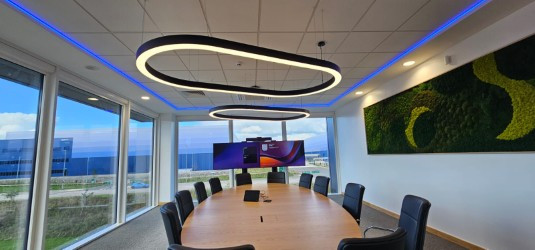The need to build two billion new homes by 2100
If the United Nations' projections are accurate, by the year 2100, our planet will be home to a staggering 11.2 billion people. That's a lot of extra mouths to feed, bodies to clothe – and if you’re in the building business – a lot of new roofs over heads. That means that the construction industry faces a monumental task – to build an estimated two billion new homes in the next 75 years, writes John Ridgeway.
This is not just a number on a spreadsheet, it's a human challenge. We need to provide safe, secure and affordable housing for billions more people, all while grappling with dwindling resources and the ever-present threat of climate change. The traditional "build it and they will come" approach simply will not cut it any longer. The future of construction needs to be efficient, sustainable and innovative – and here's why.
Africa is projected to experience the most significant population growth by 2100, with a potential population increase of over 4 billion. This rapid growth will necessitate a substantial increase in housing units across the continent.
South Asia, including countries like India, Pakistan and Bangladesh, are expected to see significant population growth as well. This region already faces challenges with housing shortages and the situation is likely to become more acute in the coming decades.
The UN report also highlights the trend of urbanisation. As populations grow, more people are expected to migrate to cities in search of jobs and opportunities. This will put a strain on existing urban infrastructure, including housing. Against this background, it is estimated that some1.6 billion people globally will live in inadequate housing conditions as early as 2030.
As an industry, we have been slow to respond and have squandered resources that will be needed for new homes in the future. For decades, construction has relied on a linear model. We extract raw materials, build structures and then dispose of waste at the end of a building's lifespan. This approach is not only wasteful but also contributes significantly to environmental degradation.
The construction sector is a major consumer of resources such as concrete, steel and timber. Unsustainable practices are leading to the depletion of these resources, putting a strain on the environment – and potential shortages for the future.
Construction also generates a staggering amount of waste, including demolition debris and a whole range of unwanted byproducts. This waste often ends up in landfills, taking up valuable space and polluting the environment. Furthermore, many traditional buildings are energy inefficient, contributing to greenhouse gas emissions and climate change. It means – we need a major re-think.
The good news
The good news is, that innovation is changing the game. The construction industry is slowly but, surely embracing a new era of sustainability, with a focus on minimising environmental impact while maximising efficiency and affordability.

Modular construction - breaking down construction into prefabricated modules built in a controlled environment, is helping to reduce waste, improve quality control and is allowing for faster project completion times.
Sustainable alternatives such as recycled steel, bamboo and bio-based composites are gaining traction. These materials have a lower environmental footprint and frequently offer superior performance and durability.
Instead of tearing down and rebuilding, we are focusing more on renovating existing structures promoting resource conservation and breathing new life into older buildings. Building Information Modelling (BIM) is also allowing for virtual 3D design and simulation, minimising errors and optimising resource usage. Additionally, prefabrication using robotics and automation promises even greater efficiency and reduced waste on construction sites.
Challenges and obstacles
The transition to sustainable construction for future homes, is not without its challenges. Introducing sustainable practices often involves increased upfront costs for new technologies and materials. However, these costs can often be offset by long-term energy savings and reduced waste disposal fees.
It is also obvious that not all stakeholders in the construction industry are fully aware of the benefits and cost-effectiveness of sustainable practices. Increased education and knowledge-sharing are crucial for wider adoption. In some cases, existing regulations and building codes may need to be fully aligned with sustainable building practices. Furthermore, policymakers will need to incentivise and streamline the adoption of sustainable technologies and materials.
Building a sustainable future
The expected housing boom of the 21st century will require a concerted effort from all stakeholders in the construction industry if we are to hit that two billion target. Architects, engineers, contractors and material suppliers will need to work together to design and build homes that are not only functional, but also environmentally responsible.
Government and private sector investments will be crucial for developing new sustainable construction technologies and materials. This will help bring down costs and enhance the performance of green building solutions.
Educating consumers about the benefits of sustainable housing choices is also essential. As consumers become more knowledgeable, they will likely drive demand for eco-friendly construction practices.
While the focus has been on building new homes, sustainable principles also apply to renovation and retrofitting existing structures. Upgrading older buildings for energy efficiency and improved performance can be a more sustainable and cost-effective option compared to new construction in some cases.
The concept of a "circular economy" is also gaining traction in the construction industry. This approach aims to minimise waste by keeping materials in use for as long as possible. Techniques like deconstruction and material reuse can significantly reduce the environmental footprint of construction projects.
Smart homes
While the UN targets may seem daunting, we must also remember that people live in homes. That means it is also about creating smart and healthy living environments. Integrating smart technologies like energy-efficient appliances, automated lighting and climate control systems and smart irrigation can significantly reduce energy consumption and water waste. This not only benefits the environment but also creates a more comfortable and convenient living experience for homeowners.
Incorporating green spaces, rain gardens and permeable pavements into building design will also help to manage stormwater runoff, reduce the heat island effect and promote biodiversity in urban areas. This creates a more sustainable and aesthetically pleasing environment around our homes.
However, building sustainable homes is just one piece of the puzzle. Going that one step further by creating truly sustainable communities will require a holistic approach that considers transportation, infrastructure and access to essential services.
Developing walkable neighbourhoods with easy access to public transportation options helps reduce reliance on personal vehicles and promotes a more sustainable way of life. Investment in cycling infrastructure and electric vehicle charging stations further promotes cleaner transportation choices and this will become more important in the next 75 years.
Creating communities that integrate residential and commercial spaces that reduce commuting needs and encourages pedestrian traffic will also be critical. This will help foster a sense of community and will contribute to a more vibrant and sustainable urban environment.
A call to action
Without doubt, the population boom and climate crisis present significant challenges for the construction industry. However, these challenges also represent an incredible opportunity. By embracing sustainable practices, innovation and collaboration, we can build a future where homes are not just places to live, but symbols of our commitment to a healthy planet and a thriving society.
By working together, we can build a bonanza of sustainable homes that are not only affordable and functional, but also leave a positive legacy for generations to come. The coming decades will see an unprecedented expansion of human habitation. How we choose to build will have a lasting impact on the planet and the well-being of future generations.
It is not just about building homes - it's about building a legacy. Let's make it a sustainable one.
Additional Blogs

Utilities consultants: providing the vital support every construction project needs
The UK’s cost of living crisis is adding significant financial challenges for everyone across the built environment, not least property developers and builders. While utilities consultants can’t do...
Read moreWhy cutting down trees will not solve the UK’s subsidence crisis
Across the UK, thousands of healthy, mature trees are being cut down each year in the name of protecting homes from subsidence. The issue is especially acute in the clay areas of southern England,...
Read more

The changing face of workplace AV and what FM managers need to know
In today’s hybrid workplaces, facilities managers can no longer treat audio-visual systems as background infrastructure - they are now mission-critical assets that directly influence productivity,...
Read more